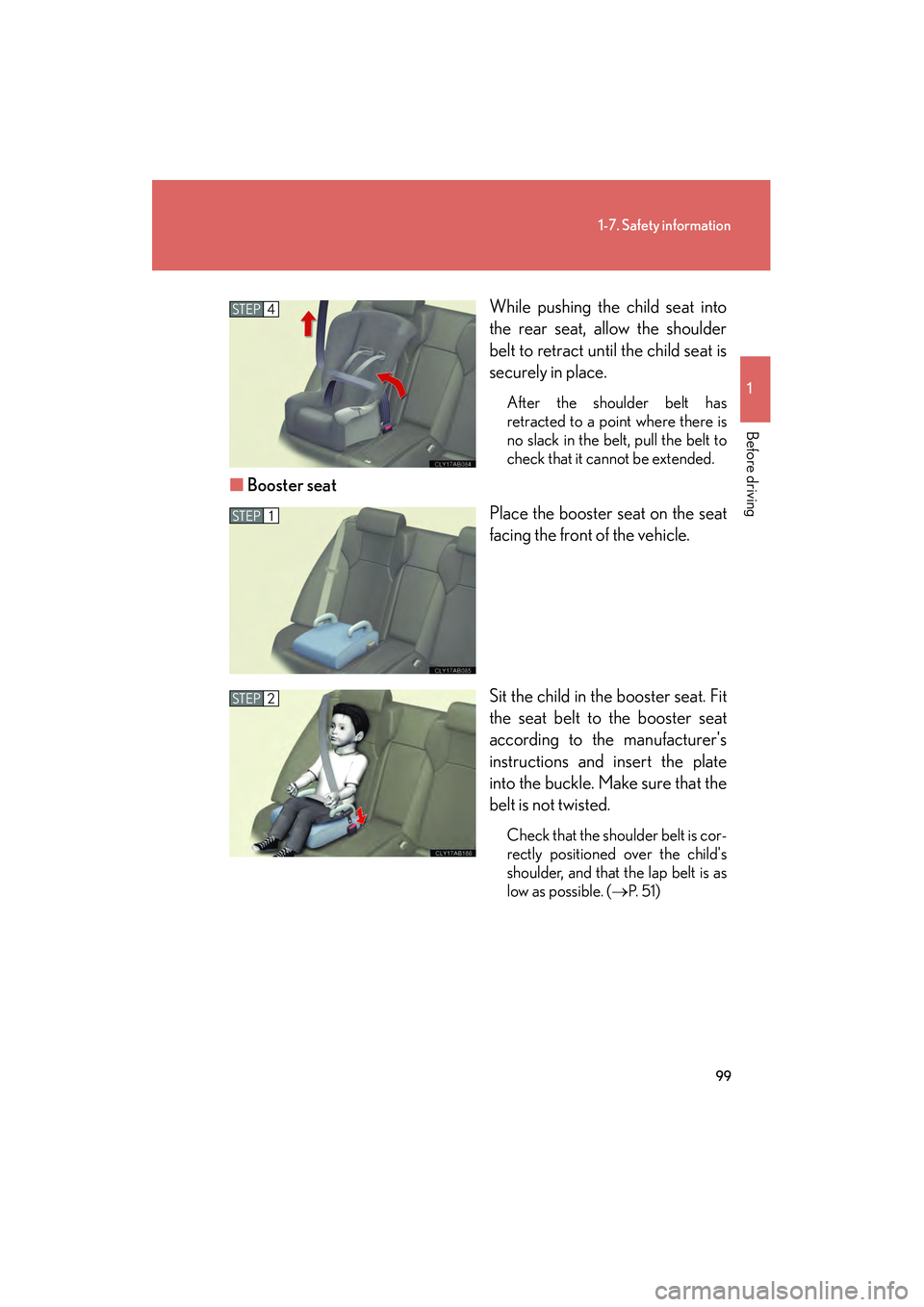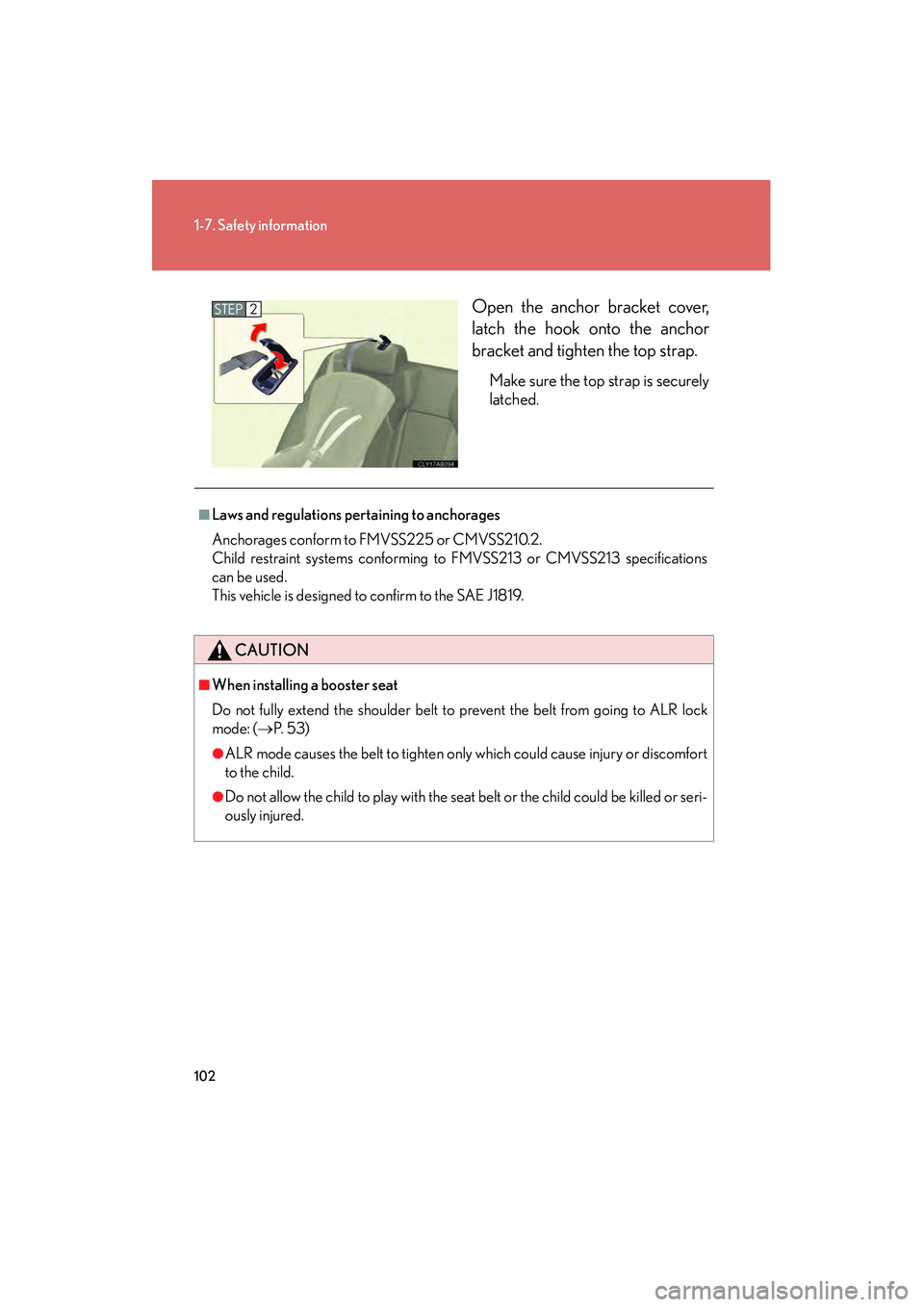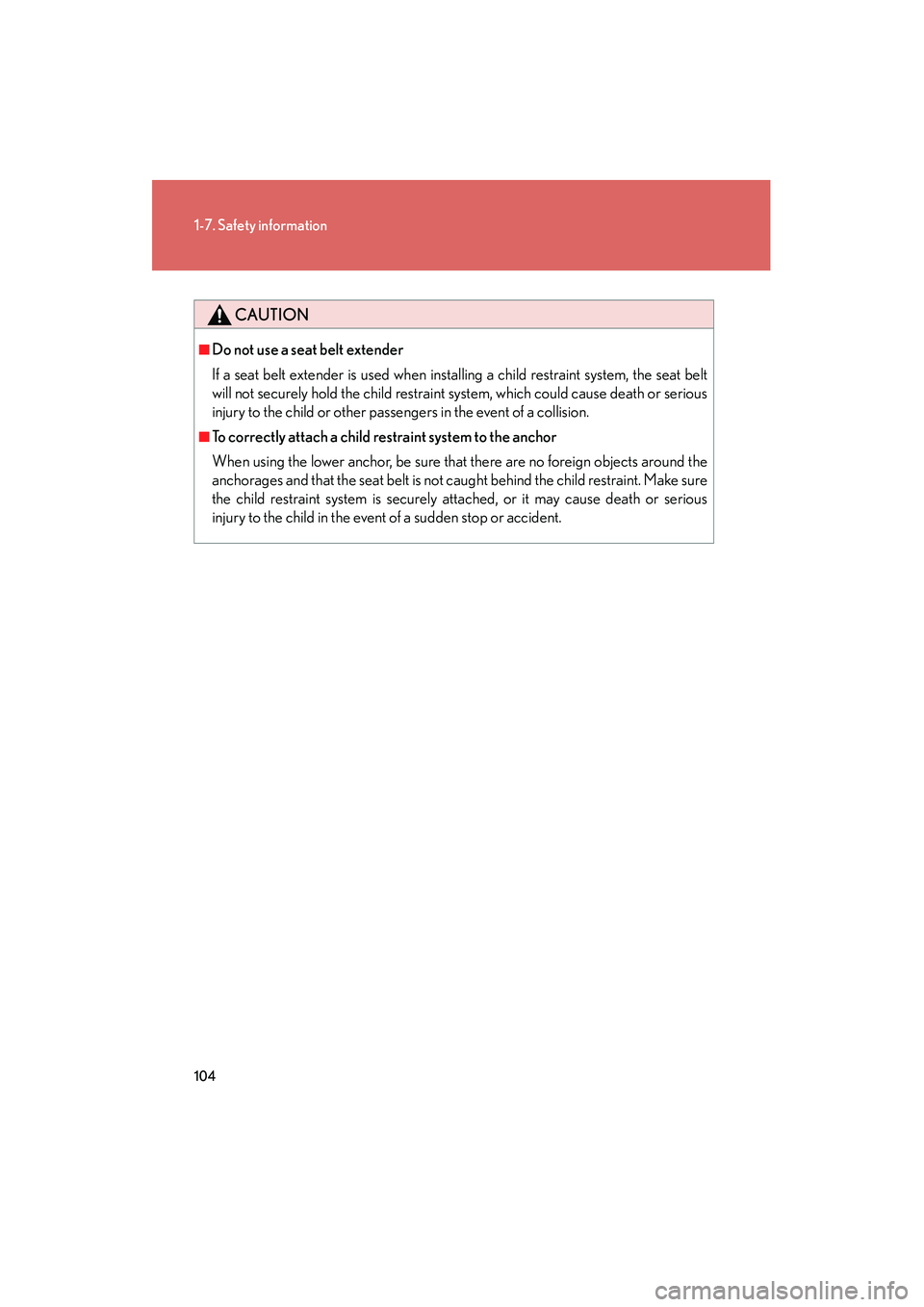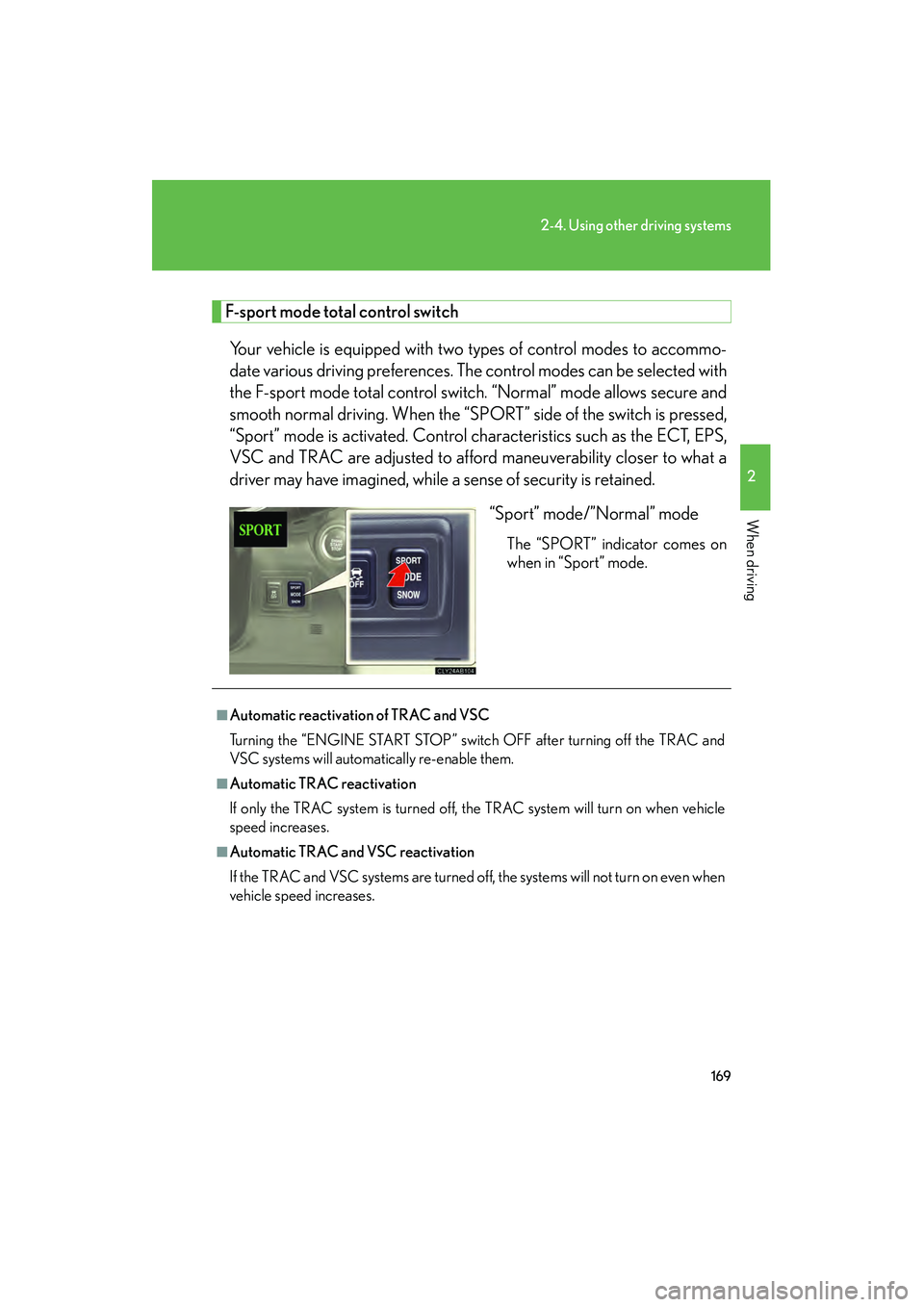ECU Lexus IS F 2008 User Guide
[x] Cancel search | Manufacturer: LEXUS, Model Year: 2008, Model line: IS F, Model: Lexus IS F 2008Pages: 454, PDF Size: 6.26 MB
Page 99 of 454

98
1-7. Safety information
08_IS F_U_(L/O_0711)While pushing the child seat down
into the rear seat, allow the shoul-
der belt to retract until the child
seat is securely in place.
After the shoulder belt has
retracted to a point where there is
no slack in the belt, pull the belt to
check that it cannot be extended.
■
Forward facing Convertible seat
Place the child seat on the seat
facing the front of the vehicle.
Run the seat belt through the child
seat and insert the plate into the
buckle. Make sure that the belt is
not twisted.
Fully extend the shoulder strap and
then allow it to retract slightly into
the ALR lock mode.
Lock mode allows the seat belt to
retract only.
STEP4
STEP1
STEP2
STEP3
Page 100 of 454

99
1-7. Safety information
1
Before driving
08_IS F_U_(L/O_0711)While pushing the child seat into
the rear seat, allow the shoulder
belt to retract until the child seat is
securely in place.
After the shoulder belt has
retracted to a point where there is
no slack in the belt, pull the belt to
check that it cannot be extended.
■
Booster seat
Place the booster seat on the seat
facing the front of the vehicle.
Sit the child in the booster seat. Fit
the seat belt to the booster seat
according to the manufacturer's
instructions and insert the plate
into the buckle. Make sure that the
belt is not twisted.
Check that the shoulder belt is cor-
rectly positioned over the child's
shoulder, and that the lap belt is as
low as possible. (→
P. 5 1)
STEP4
STEP1
STEP2
Page 102 of 454

101
1-7. Safety information
1
Before driving
08_IS F_U_(L/O_0711)Ty p e B
Widen the gap between
the seat cushion and
seatback slightly.
Latch the buckles onto the
anchors.
If the child restraint has a top
strap, the top strap should be
latched onto the anchorages.
For owners in Canada:
The symbol on a child restraint sys-
tem indicates the presence of a
lower connector system.
Child restraint systems with a top strap
Secure the child restraint using a
seat belt or the lower anchors, and
lock the head restraint in place at
the lowest position.
Canada only
STEP1
STEP2
STEP1
Page 103 of 454

102
1-7. Safety information
08_IS F_U_(L/O_0711)Open the anchor bracket cover,
latch the hook onto the anchor
bracket and tighten the top strap.
Make sure the top strap is securely
latched.
STEP2
■Laws and regulations pertaining to anchorages
Anchorages conform to FMVSS225 or CMVSS210.2.
Child restraint systems conforming to FMVSS213 or CMVSS213 specifications
can be used.
This vehicle is designed to confirm to the SAE J1819.
CAUTION
■When installing a booster seat
Do not fully extend the shoulder belt to prevent the belt from going to ALR lock
mode: (
→P. 5 3 )
●ALR mode causes the belt to tighten only which could cause injury or discomfort
to the child.
●Do not allow the child to play with the seat belt or the child could be killed or seri-
ously injured.
Page 104 of 454

103
1-7. Safety information
1
Before driving
08_IS F_U_(L/O_0711)
CAUTION
■When installing a child restraint system
Follow the directions given in the child restraint system installation manual and fix
the child restraint system securely in place.
If the child restraint system is not correctly fixed in place, the child may be injured or
even killed in the event of sudden braking or an accident.
●When a booster seat is installed, always ensure that the shoulder belt is posi-
tioned across the center of the child's shoulder. The belt should be kept away
from the child's neck, but not so that it could fall off the child's shoulder. Failing to
do so may result in death or serious injury in the event of an accident or sudden
braking.
●Ensure that the belt and tab are securely locked and the seat belt is not twisted.
●Push and pull the child restraint system in different directions to be sure it is
secure.
●Follow all installation instructions provided by the child restraint system manufac-
turer.
●If the driver’s seat interferes with the child
restraint system and prevents it from being
attached correctly, attach the child restraint
system to the right-hand rear seat.
●Only put a forward facing or booster child
seat on the front seat when unavoidable.
When installing a forward facing or
booster child seat on the front passenger
seat, move the seat as far back as possible
even if the “AIR BAG OFF” indicator light is
illuminated. Failing to do so may result in
death or serious injury if the airbags deploy
(inflate).
Page 105 of 454

104
1-7. Safety information
08_IS F_U_(L/O_0711)
CAUTION
■Do not use a seat belt extender
If a seat belt extender is used when installing a child restraint system, the seat belt
will not securely hold the child restraint system, which could cause death or serious
injury to the child or other passengers in the event of a collision.
■To correctly attach a child restraint system to the anchor
When using the lower anchor, be sure that there are no foreign objects around the
anchorages and that the seat belt is not caught behind the child restraint. Make sure
the child restraint system is securely attached, or it may cause death or serious
injury to the child in the event of a sudden stop or accident.
Page 156 of 454

155
2-4. Using other driving systems
2
When driving
08_IS F_U_(L/O_0711)Example of follow-up cruising (when following a vehicle driving slower
than the set speed): When the speed is set to 62 mph (100 km/h) and
the vehicle ahead is driving at 50 mph (80 km/h)
The system continues follow-up cruising while adjusting for changes in the
speed of the vehicle ahead in order to maintain the vehicle-to-vehicle dis-
tance set by the driver.
Example of acceleration (when ther
e are no longer vehicles driving
slower than the set speed in the lane ahead): Wh en the speed is set to
62 mph (100 km/h) and the vehicle ahead driving at 50 mph (80
km/h) is out of the lane
When the vehicle ahead of you executes a lane change, the system slowly
accelerates until the set vehicle speed is reached. The system then returns to
fixed speed cruising.
■Dynamic radar cruise control warning lights, messages and buzzers
Warning lights, messages and buzzers are used to indicate a system malfunction or
to alert you to the need for caution while driving. ( →P. 3 6 0 )
■The dynamic radar cruise can be set when
●The shift lever is in the D position. However, it cannot be set if any of the ranges 1
through 3 has been selected using the paddle shift switches.
●Vehicle speed is between approximately 30 mph (45 km/h) and 85 mph (135
km/h).
■Accelerating
The vehicle can be accelerated normally.
Page 170 of 454

169
2-4. Using other driving systems
2
When driving
08_IS F_U_(L/O_0711)
F-sport mode total control switchYour vehicle is equipped with two types of control modes to accommo-
date various driving preferences. The control modes can be selected with
the F-sport mode total control switch. “Normal” mode allows secure and
smooth normal driving. When the “SPORT” side of the switch is pressed,
“Sport” mode is activated. Control characteristics such as the ECT, EPS,
VSC and TRAC are adjusted to afford maneuverability closer to what a
driver may have imagined, while a sense of security is retained. “Sport” mode/”Normal” mode
The “SPORT” indicator comes on
when in “Sport” mode.
■Automatic reactivation of TRAC and VSC
Turning the “ENGINE START STOP” switch OFF after turning off the TRAC and
VSC systems will automatically re-enable them.
■Automatic TRAC reactivation
If only the TRAC system is turned off, the TRAC system will turn on when vehicle
speed increases.
■Automatic TRAC and VSC reactivation
If the TRAC and VSC systems are turned off, the systems will not turn on even when
vehicle speed increases.
Page 177 of 454

176
08_IS F_U_(L/O_0711)
2-5. Driving information
Cargo and luggage
Capacity and distributionCargo capacity depends on the total weight of the occupants.
(Cargo capacity) = (Total load cap acity) — (Total weight of occupants)
Steps for Determining Correct Load Limit
(1) Locate the statement “The combined weight of occupants and cargo should never exceed XXX kg or XXX lbs.” on your vehicle’s placard.
(2) Determine the combined weight of the driver and passengers that will be riding in your vehicle.
(3)Subtract the combined weight of the driver and passengers from XXX kg or XXX lbs.
(4) The resulting figure equals the available amount of cargo and luggage load capacity.
For example, if the “XXX” amount equals 1400 lbs. and there will be
five 150 lb passengers in your vehicle, the amount of available cargo
and luggage load capacity is 650 lbs. (1400 − 750 (5 × 150) = 650
lbs.)
(5)Determine the combined weight of luggage and cargo being loaded on the vehicle. That weight may not safely exceed the available cargo
and luggage load capacity calculated in Step 4.
Take notice of the following information about storage precautions, cargo
capacity and load.
●Stow cargo and luggage in the trunk whenever possible. Be sure
all items are secured in place.
● Be careful to keep the vehicle level. Placing the weight as far for-
ward as possible helps maintain vehicle balance.
● For better fuel economy, do not carry unnecessary weight.
Page 179 of 454

178
2-5. Driving information
08_IS F_U_(L/O_0711)
CAUTION
■Things that must not be carried in the trunk
The following things may cause a fire if loaded in the trunk.
●Receptacles containing gasoline
●Aerosol cans
■Storage precautions
●Do not place items in or on the following locations:
• At the feet of the driver
• On the front passenger or rear seats (when stacking items)
• Package tray (behind the rear seatback)
• Instrument panel
•Dashboard
Items placed in the above locations could get thrown around in the event of sud-
den braking or an accident and injure the vehicle occupants.
In addition, items could block the driver’s field of vision or move during sharp
acceleration or turning. If items move about they may get under the brake or
accelerator pedals, preventing them from being depressed properly, or hit the
driver or passengers. In these situations, the driver’s control of the vehicle could
be impaired, causing an accident.
●Secure all items in the occupant compartment, as they may shift and injure some-
one during an accident or sudden braking.
■Luggage capacity and distribution
Observe the following precautions. Failure to do so will not only put load on the
tires, but also reduce steering and braking performance. This could lead to an acci-
dent resulting in serious injury or even death.
●Do not overload the vehicle.
●Do not apply load to the vehicle unevenly.